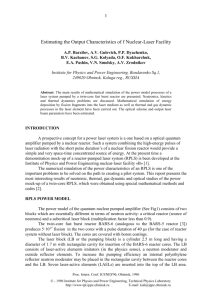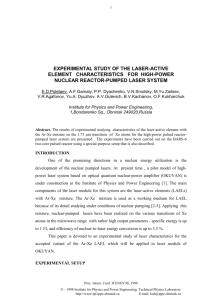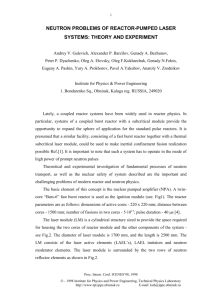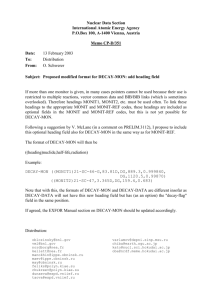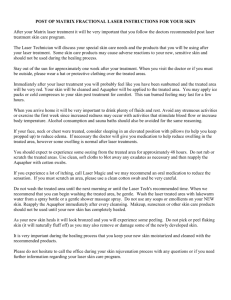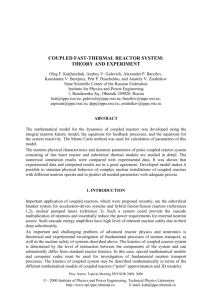Experiment
advertisement
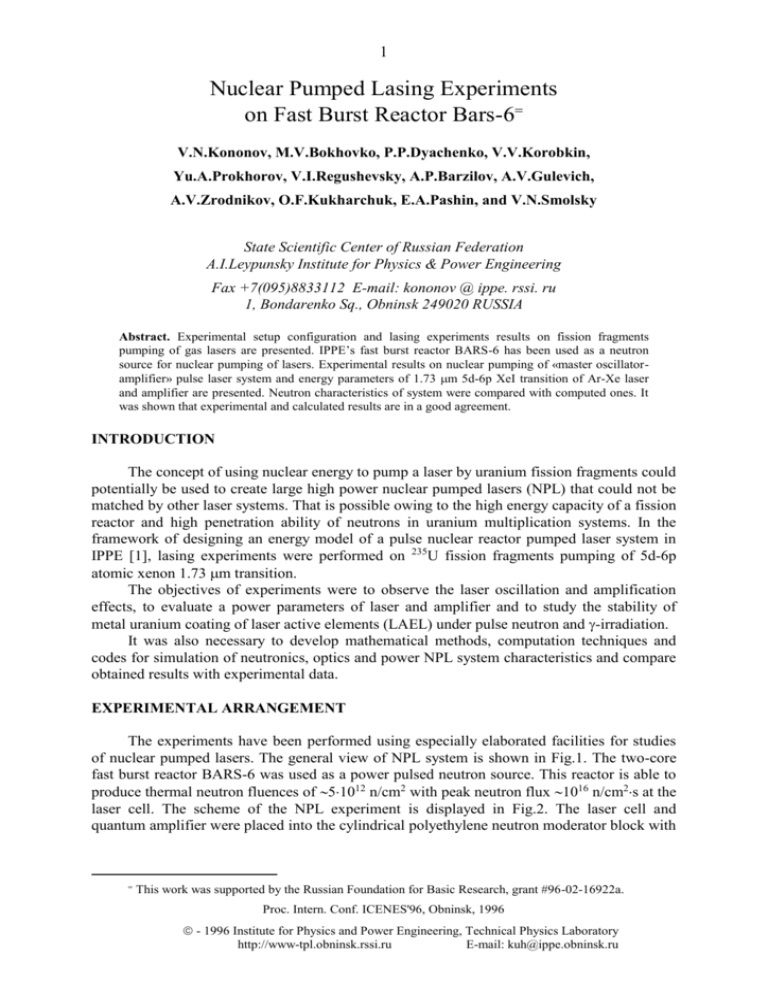
1 Nuclear Pumped Lasing Experiments on Fast Burst Reactor Bars-6 V.N.Kononov, M.V.Bokhovko, P.P.Dyachenko, V.V.Korobkin, Yu.A.Prokhorov, V.I.Regushevsky, A.P.Barzilov, A.V.Gulevich, A.V.Zrodnikov, O.F.Kukharchuk, E.A.Pashin, and V.N.Smolsky State Scientific Center of Russian Federation A.I.Leypunsky Institute for Physics & Power Engineering Fax +7(095)8833112 E-mail: kononov @ ippe. rssi. ru 1, Bondarenko Sq., Obninsk 249020 RUSSIA Abstract. Experimental setup configuration and lasing experiments results on fission fragments pumping of gas lasers are presented. IPPE’s fast burst reactor BARS-6 has been used as a neutron source for nuclear pumping of lasers. Experimental results on nuclear pumping of «master oscillatoramplifier» pulse laser system and energy parameters of 1.73 m 5d-6p XeI transition of Ar-Xe laser and amplifier are presented. Neutron characteristics of system were compared with computed ones. It was shown that experimental and calculated results are in a good agreement. INTRODUCTION The concept of using nuclear energy to pump a laser by uranium fission fragments could potentially be used to create large high power nuclear pumped lasers (NPL) that could not be matched by other laser systems. That is possible owing to the high energy capacity of a fission reactor and high penetration ability of neutrons in uranium multiplication systems. In the framework of designing an energy model of a pulse nuclear reactor pumped laser system in IPPE [1], lasing experiments were performed on 235U fission fragments pumping of 5d-6p atomic xenon 1.73 m transition. The objectives of experiments were to observe the laser oscillation and amplification effects, to evaluate a power parameters of laser and amplifier and to study the stability of metal uranium coating of laser active elements (LAEL) under pulse neutron and -irradiation. It was also necessary to develop mathematical methods, computation techniques and codes for simulation of neutronics, optics and power NPL system characteristics and compare obtained results with experimental data. EXPERIMENTAL ARRANGEMENT The experiments have been performed using especially elaborated facilities for studies of nuclear pumped lasers. The general view of NPL system is shown in Fig.1. The two-core fast burst reactor BARS-6 was used as a power pulsed neutron source. This reactor is able to produce thermal neutron fluences of 51012 n/cm2 with peak neutron flux 1016 n/cm2s at the laser cell. The scheme of the NPL experiment is displayed in Fig.2. The laser cell and quantum amplifier were placed into the cylindrical polyethylene neutron moderator block with This work was supported by the Russian Foundation for Basic Research, grant #96-02-16922a. Proc. Intern. Conf. ICENES'96, Obninsk, 1996 - 1996 Institute for Physics and Power Engineering, Technical Physics Laboratory http://www-tpl.obninsk.rssi.ru E-mail: kuh@ippe.obninsk.ru 2 external 2602000 mm and internal 160 mm covered by cadmium sheets. The laser cell is a thin walled stainless steel tube with outer diameter 49 mm and length 400 mm. From one side it was equipped with 6-m curvature concave gold high reflection spherical mirror and on the other side - with a quartz Brewster’s window. A flat dielectric mirror with reflectivity 95% at 1.73 m was used as an output coupler. A 300-mm-long aluminum cylinder coated with a 235U dioxide layer of thickness 2.7 mg/cm2 was placed into the laser cell. The laser active element was used as a quantum amplifier. It is a similar stainless steel tube 492500 mm with internal 5-m-thick metal 235U coating. Both sides of the LAEL were hermetically sealed with quartz optic windows having a dielectric antireflection coating for 1.73 m. In order to cover the internal surface of LAEL by metal 235 U film the magnetron dispersion method was used [2]. Both the laser cell and LAEL were filled with Ar+0.5%Xe gas mixture at 380 Torr pressure. Moderated reactor neutrons produce fission reactions in the 235U laser cell and amplifier coatings. A fraction of the fission fragments escape from the coatings and deposit their kinetic energy into the lasing medium as ionization and excitation. As a result, an inversion population is created in the lasing medium. The optic scheme of experiment has two channels which were created by beamsplitter placed on the amplifier input. The transmission of beamsplitter was 0.32. The high reflection mirror with 10 m radius of curvature has been used for a two-round-trip amplifier scheme. In order to eliminate the uncertainty connected with the limitation of laser beam cross section in both channels, a restrictive 16-mm aperture was placed in front of the splitter plate. As determined computationally, for this case the cross section of the laser beam does not restrict along whole optical tract in both channels. The plate aluminum and spherical dielectric mirrors were used as turning ones. Tuning of optical system and transmission measurements were carried out using a He-Ne laser. The measured transmission in the input channel was 6.310-2, and 1.910-2 in the output channel of the amplifier. A thermocouple calorimeter and germanium photodiodes were been used for registration of laser energy and time behavior of laser pulse. Registration of the photodiode signal was performed with digital system based on CAMAC modules connected to a personal computer [3]. Synchronization of measuring system was made from reactor radiation signal. The gold activation indicators attached on the external surface of LAEL were used for measurement of the thermal neutron fluence distribution and calculation of amount of fissions in uranium coatings. The induced activation of 198Au was measured by single-crystal NaJ(Tl) 150100 mm spectrometer on 412-keV gline. The photoefficiency of the spectrometer was calibrated using standard g-ray sources in wide energy diapason. The accuracy of induced activation and thermal neutron fluence measurement was ~3%. The time behavior of thermal neutron pumping pulse was measured by vacuum fission chamber with 235U [4]. EXPERIMENTAL RESULTS AND DISCUSSION Typical time-dependent 1.73-m atomic xenon laser output in a free oscillation mode and thermal neutron signal are shown in Fig.3. The total laser oscillator output energy without restrictive aperture and beamsplitter was 200 mJ. The thermal neutron signal from the vacuum 235 U fission chamber has been normalized to the thermal neutron fluence measured by activation method. Laser output signal from Ge-photodiode has been normalized to total energy measured by calorimeter. The pump power has been evaluated from thermal neutron flux value and fission fragment energy deposition into the laser medium. The last value was Proc. Intern. Conf. ICENES'96, Obninsk, 1996 - 1996 Institute for Physics and Power Engineering, Technical Physics Laboratory http://www-tpl.obninsk.rssi.ru E-mail: kuh@ippe.obninsk.ru 3 obtained with Monte Carlo simulation of fission fragment stopping [5]. Input and output amplifier intensity are presented in Fig.4. The registration energy gain in amplifier was 4. SIMULATION OF NEUTRONICS The neutron physical and power characteristics of two-zone fast burst reactor were computed using special software [6] for simulation of a coupled reactor system neutronics and dynamics. Green function method was used to simulate the time-dependent distribution of fissions produced in the laser fissile coatings by reactor neutrons. If a such function G(t) for fissile coatings is known, it is possible to find a time distribution of fissions in 235U of laser cell controlled by reactor signal of any complex time shape Nr() as Duamel integral: t N (t) G(t ) N r ()d (1) exp( l j ) (2) G() = kj j lj The Green function for that problem was approximated with exponential set (2), and then the formula (1) was numerically integrated. In (2) kj and lj are a parameters of approximation, j - the number of exponents in a set. The simplified analytical formula for the estimation of a power pulse of metal core BARS type reactor is following t 2 Er N r t exp r 2r (3) here E r and r - represent the net energy and effective pulse duration respectively. The latter one is connected with a half-duration of the pulse as 1 2 2 r ln 2 . Taking into consideration (2), after substituting (3) into (1), we shall obtain the simplified algebraical expression for the time distribution of fissions produced by reactor neutrons in the fissile laser coating: Er k j 2r N (t) exp 2 l j 4 l j j 2 t - 1 er f l j t r l 2 l j j (4) For the comparison, measured and calculated reactor pulses are shown in Fig.5. Thermal neutron fluence longitudinal distributions for LAEL and the laser cell are presented in Fig.6. Time-dependent fluence in laser cell uranium coating, evaluated analytically and computed using methods mentioned above, are shown in Fig.7 in comparison to experimental data. The Monte Carlo LOCMMO code, which utilizes a local estimation of steady-state and nonsteady-state flux functionals [7], was used for computation. It is obvious that the computed and algebraically calculated results are in a good agreement with experimental ones. Proc. Intern. Conf. ICENES'96, Obninsk, 1996 - 1996 Institute for Physics and Power Engineering, Technical Physics Laboratory http://www-tpl.obninsk.rssi.ru E-mail: kuh@ippe.obninsk.ru 4 CONCLUSION The first nuclear pumped lasing experiments on the fast burst reactor BARS-6 were performed. Laser oscillation and amplification for 5d-6p atomic xenon transitions at 1.73 m have been observed. Neutron characteristics of the system were measured and compared to computed ones. Experimental and calculated results were shown to be in good agreement. REFERENCES [1] P.P. Dyachenko, A.V. Gulevich, A.V. Zrodnikov, V.N. Kononov, and V.Ya. Poupko, «Energy model of a puls e nuclear reactor pumped laser system,» in 7th Intern. Conf. on Emerging Nuclear Energy Systems (ICENES’93), World Scientific, 372 (1994). [2] G.N. Kazantsev, N.Ya. Maximov, V.I. Uporov, A.Yu. Belomytsev, A.Yu. Perekhrest, V.G. Burdym, E.S. Kononov, and S.G. Samoylov, «Study of metal uranium dispersion processes into internal surface of laser active element,». 2nd Intern. Conf. on Physics of Nuclear Induced Plasmas and Problems of Nuclear Pumped Lasers, eds. A.M.Voinov, S.P. Melnikov, and A.A. Sinyanskii, VNIIEF, Arzamas-16,, 2, 27 (1995). [3] V.I. Regushevsky, O.E. Kononov, M.V. Bokhovko, and V.N. Kononov, «Storage digital oscillograph in the CAMAC system,» IPPE, Obninsk, Preprint #2478 (1995). [4] V.I. Regushevsky, M.V. Bokhovko, V.N. Kononov, R.H. Gubadullin, and A.U. Gonchar, «High intensity neutron flux measurement by vacuum fission chambers,» IPPE, Obninsk, Preprint #2531 (1996). [5] A.A. Androsenko, P.A. Androsenko, and E.D. Poletaev, «Using of Monte Carlo method for estimation of space-time distribution of fission fragment energy deposition,» IPPE, Obninsk, Preprint #1968 (1989). [6] A.V. Gulevich, B.V. Kachanov, and O.F. Kukharchuk, «Models and codes for reactorlaser system dynamics computation,» IPPE, Obninsk, Preprint #2454 (1995). [7] E.A. Pashin and V.B. Polevoy, «LOCMMO_T - the code for simulation of nonstationary neutron flux functionals with local estimation methods and mathematical expectation in the frame MMKFK-2 code system,» IPPE, Obninsk, Preprint #2388 (1994). Proc. Intern. Conf. ICENES'96, Obninsk, 1996 - 1996 Institute for Physics and Power Engineering, Technical Physics Laboratory http://www-tpl.obninsk.rssi.ru E-mail: kuh@ippe.obninsk.ru 5 Fig.1. Setup for nuclear pumping lasing experiments. Fig.2. The experimental setup scheme. 1-cores, 2-moderator, 3-master oscillator cell, 4-cavety mirrors, 5,6,7-turning mirrors, 8amplifier windows, 9,10-beamsplitters, 11-lenses, 12-calorimeter, 13-photodiode, 14-digital oscillograph, 15-tuning laser. Proc. Intern. Conf. ICENES'96, Obninsk, 1996 - 1996 Institute for Physics and Power Engineering, Technical Physics Laboratory http://www-tpl.obninsk.rssi.ru E-mail: kuh@ippe.obninsk.ru 6 80 8 60 6 1 40 120 15 Pump power, W/cm 3 Output power 1.73 m, W 2 2 Thermal neutron flux, 10 /cm s 160 4 80 20 40 2 0 0 0 0 200 400 600 800 1000 s Fig.3. Neutron (1) and laser (2) pulses. Time, 40 1.73 m intensity, W/cm 2 2 30 20 10 1 0 0 100 200 300 400 500 600 s Fig.4. Input (1) and output (2) amplifier intensity. 700 Time, Proc. Intern. Conf. ICENES'96, Obninsk, 1996 - 1996 Institute for Physics and Power Engineering, Technical Physics Laboratory http://www-tpl.obninsk.rssi.ru E-mail: kuh@ippe.obninsk.ru 7 20.0 Fast neutron flux, rel.units 17.5 - experiment 15.0 - numerical simulation - analytical formula 12.5 10.0 7.5 5.0 2.5 0.0 0 100 200 Time, s 300 400 Fig.5. Neutron reactor pulse. 2.5 - experiment - numerical simulation Thermal neutron fluense, 10 12 cm-2 3.0 2.0 1.5 1.0 0.5 0.0 0 50 100 150 200 250 Length of laser cell, cm Fig.6. Thermal neutron fluence distribution along laser cell. Proc. Intern. Conf. ICENES'96, Obninsk, 1996 - 1996 Institute for Physics and Power Engineering, Technical Physics Laboratory http://www-tpl.obninsk.rssi.ru E-mail: kuh@ippe.obninsk.ru 8 Thermal neutron flux, 10 15 cm-2s -1 6 5 - experiment - numerical simulation - analytical formula 4 3 2 1 0 100 200 300 400 500 600 Time, 700 s 800 900 1000 1100 1200 Fig.7. Thermal neutron pulse on the surface of a laser cell. Proc. Intern. Conf. ICENES'96, Obninsk, 1996 - 1996 Institute for Physics and Power Engineering, Technical Physics Laboratory http://www-tpl.obninsk.rssi.ru E-mail: kuh@ippe.obninsk.ru
